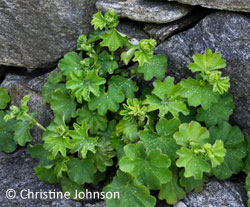 Outer Hebrides Biological Recording
Outer Hebrides Biological Recording
 Outer Hebrides Biological Recording
Outer Hebrides Biological Recording

Invasive Non-native Species - Plants
Canadian Waterweed, Elodea canadensis, and Nuttall's Waterweed, Elodea nuttallii, are aquatic invasive non-native species now found throughout the UK. They live in freshwater as perennial, submerged waterweeds and although they produce small white flowers they only reproduce vegetatively as all plants are female. Canadian Waterweed was first found in Britain in 1842, whilst Nuttall's Waterweed, which is found in more nutrient-rich water, was not recorded as naturalised in Britain in 1966.
The invasion of the freshwater lochs of the islands by invasive alien aquatic plants can have serious detrimental effects on their biodiversity and economic value. Both species of Elodea have been recorded here and it is importance that their distribution is monitored. Their spread can be impeded by ensuring that everyone who uses the lochs for follows the Check-Clean-Dry biosecurity guidance.
First introduced as garden plants from South America, Giant Rhubarb Gunnera species is now naturalised and present throughout the UK. It is a large, clump-forming perennial with umbrella-sized leaves and stems up to 2 m tall. The plant dies down in the winter but grows new leaves in spring. The seeds are spread through watercourses and by birds and once established form dense colonies, suppressing native plants and blocking drainage ditches and pipes.
It is more widely distributed than the distribution maps suggests and is a serious problem in parts of Harris, although measures are being take to try and eradicated it.
Introduced as a garden plant in the early 19th century Himalayan Balsam, Impatiens glandulifera, was first recorded in the wild in 1855 and is now common throughout the UK.
It has explosive seed heads and the small seeds are easily dispersed by wind or water. It is very invasive, spreads rapidly suppressing native plant growth and it can cause erosion on river banks
Growing in dense thickets with bamboo like stems Japanese Knotweed, Fallopia japonica, is an invasive and often destructive perennial. Introduced in the early 19th century as an ornamental plant, it is now common and widespread across the UK.
It does not produce viable seed and is spread by the dispersal of fragments of stem or rhizomes. The dense growth smothers the local flora, and may cause structural damage erosion and flooding along watercourses.

Alchemilla mollis, lady's-mantle, is a vigorous herbaceous perennial plant native to southern Europe and grown throughout the world as an ornamental garden plant. It has lime green flowers and large, light green, fan like, hairy and slightly pleated leaves.
It reproduces mainly by seed, which is produced abundantly, but it can also spread by rhizome fragments. Cultivated in Britain since 1874, was first recorded in the wild in 1948 and is now found throughout the UK. In the Outer Hebrides it appears to be more widely recorded in the north of Lewis, but it is colonising new areas. Introductions into new areas could be prevent by gardeners and horticulturists adopting the Be Plant Wise guidelines.
Monkeyflower, Mimulus guttatus is a tall, upright plant which produces large, yellow flowers, sometimes with orange markings. It is usually found in wet habitats, growing along streams, ditches, rivers and lakes, in wet pastures; and occasionally on disturbed ground. A native of North America, it has been present in Britain since the mid-19th century.
In suitable habitats it can form very dense stands, possibly to the detriment of the local native flora. Introductions into new areas could be prevent by gardeners and horticulturists adopting the Be Plant Wise guidelines.
Montbretia (various Crocosmia hybrids and varieties) was introduced as a garden plant in the late 19th century and had already become naturalised by the beginning of the 20th century. It is spread by rhizomes and is distributed mainly through the dispersal of garden waste.
It forms dense clumps, spreads rapidly and will dominate the local flora. Although now widely distributed, introductions into new areas could be prevent by gardeners and horticulturists adopting the Be Plant Wise guidelines.
Rhododendron (mainly Rhododendron ponticum) was introduced by gardeners in the late 18th century into parks and woodlands, where it was also used for game cover and stock shelters.
It spreads by suckers and seeds, which are small and can be carried long distances by wind. It forms dense thickets which shade out native plants, prevent the regeneration of trees and ground vegetation on moors. It is poisonous to livestock and cannot be controlled by grazing.
Rhododendron ponticum is also a host of the fungal disease organisms Phytophthora ramorum and P. kernoviae, which attack oak and beech.